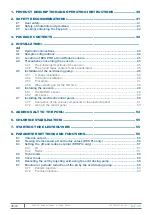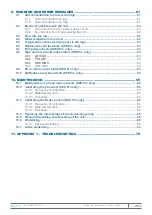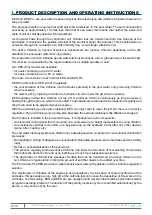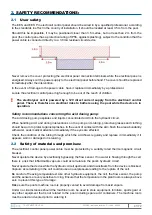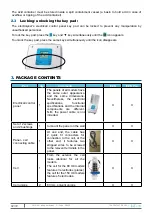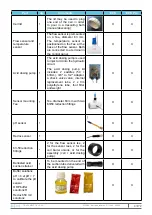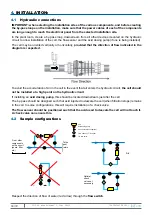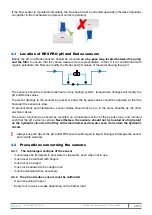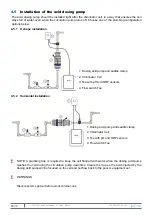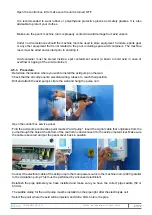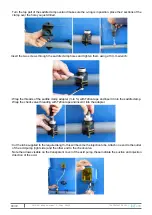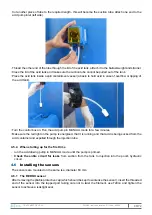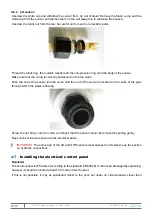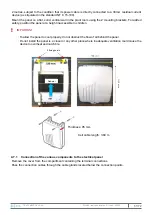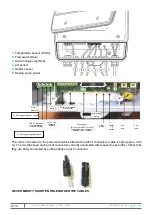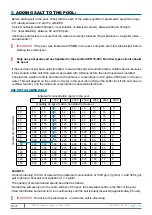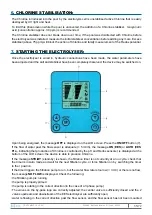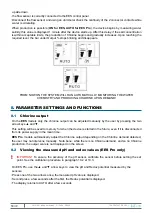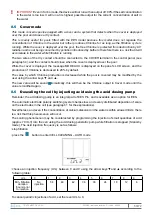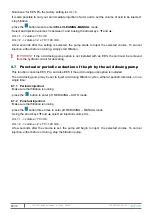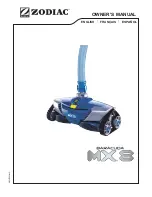
2019/08 - Indice de révision : D - Code : 29650
TRAITEMENT DE L'EAU
45/72
If the flow sensor is mounted horizontally, the blue head must be oriented upwards (otherwise impurities
can gather in the mechanism and prevent correct operation).
Exemples de con
fi
gura
ti
ons de montage possibles :
Depuis les
autres organes
du circuit
(pompe,
fil
tre
chau
ff
age…)
Vers le
retour
bassin
OK
Op
ti
mal,
clapet non
nécessaire
Cellule
Pompe pH-clear
Clapet an
ti
-retour (non fourni)
Détecteur débit + sonde T°C
Vanne ¼ de tour
4.3
Location of EES PRO pH and Redox sensors
Ideally, the pH and Redox sensors should be mounted
on a by-pass loop located between the pump
and the filter
to ensure that the values measured are representative. In fact, if it is contaminated with
organic pollutants, the filter can modify the Redox and pH values of the water flowing though it.
e
ff
et, lorsqu’il est encrassé par de la pollu
ti
on organique, le
fi
ltre peut modi
fi
er les valeurs
de Rédox et de pH de l’eau qui la traverse.
Les sondes doivent être montées avant l’appareil de chau
ff
age de l’eau : un changement de
température modi
fi
e les valeurs de pH et de Rédox.
A
fi
n de préserver les sondes de tout endommagement par des gravillons ou du sable, on
règlera les vannes du by-pass de façon à ce que le débit à travers le by-pass des sondes soit
faible.
Les câbles des sondes ne doivent pas être regroupés dans des gaines avec d’autres câbles
électriques, pour éviter le parasitage et les interférences.
Le té portant les sondes sera monté sur une
por
ti
on horizontale
du circuit by-pass,et orienté
pour que la
sonde pH soit en posi
ti
on ver
ti
cale. Néanmoins, les sondes ne doivent pas être
situées en un point « haut » du circuit hydraulique pour éviter qu’elles ne se retrouvent
hors d’eau en cas de prise d’air
Précau
ti
ons vis-à-vis des sondes :
Les par
ti
es immergées des sondes :
-
doivent toujours rester immergées (eau de piscine ou du robinet), même hors
fonc
ti
on
-
ne doivent jamais être touchées avec les doigts
-
ne doivent jamais être essuyées
-
ne doivent jamais être soumises au gel
-
doivent être détartrées le cas échéant
La sonde pH doit être étalonnée :
-
après ré-ouverture de la piscine
-
mensuellement à trimestriellement en période d’uilisa
ti
on, selon la fréquenta
ti
on de
la piscine
The sensors should be mounted upstream of any heating system: temperature changes will modify the
pH and Redox values.
To prevent damage to the sensors by gravel or sand, the by-pass valves should be adjusted so that the
flow past the sensors is slow.
To prevent static and interference, sensor cables should not be run in the same sheaths as the other
electrical cables.
The sensor mounting tee should be mounted on a horizontal section of the by-pass loop, and oriented
such that the pH sensor is vertical.
Nevertheless, the sensors should not be located at a high point
on the hydraulic circuit so that they will remain immersed in water even if air enters the hydraulic
circuit.
!
Always keep the tips of the pH and ORP sensors submerged in liquid. Drying will damage the sensor
and void its warranty
4.4
Precautions concerning the sensors
4.4.1 The submerged sections of the sensor
•
must always be immersed in pool water or tap water, even when not in use
•
must never be touched with fingers
•
must never be wiped
•
must not be allowed to be caught in ice
•
must be descaled when necessary
4.4.2 the ph and redox sensors must be calibrated
•
Upon reopening the pool
•
Every four to twelve weeks depending on the bather load


